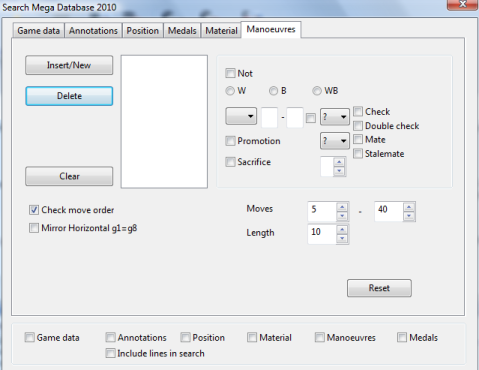|
Search mask – Manoeuvres |

|

|
|
|
Search mask – Manoeuvres |

|

|
Search mask – Manoeuvres
Search mask, Manoeuvres.

Searching for manoeuvres retrieves sequences of moves. This is unlike the position search which provide a static picture and is insufficient when you interested in finding out how a certain position has come about. In addition, the manoeuvre search can be used to find a wide range of tactical motifs.
In the above example we are looking for games in which a white bishop moved from somewhere to f7 capturing a pawn ("wB??f7xP"), the black king recaptured the bishop ("bK??f7xB"), after which a white knight delivered check on g5 ("wN??g5+"). "Check move order" means the moves must have occurred in that order, "Length" that it had to be within three ply, "Mirror horizontal" that it could be a black bishop capturing on h2.
How to define a manoeuvre
![]() Colour: The boxes W, B and WB select which side makes the move in question.
Colour: The boxes W, B and WB select which side makes the move in question.
![]() Piece: The piece type is selected from the list of pieces that appears when you click the arrow down symbol. Use the question mark to denote an arbitrary piece.
Piece: The piece type is selected from the list of pieces that appears when you click the arrow down symbol. Use the question mark to denote an arbitrary piece.
![]() Squares: The start and destination square are given in long notation (“e2e4”). Use the question mark as a joker: For example, “?3?3” means any move along the third rank, “??h7” means from anywhere to h7. You must first delete a question mark before entering a number or a character in its place.
Squares: The start and destination square are given in long notation (“e2e4”). Use the question mark as a joker: For example, “?3?3” means any move along the third rank, “??h7” means from anywhere to h7. You must first delete a question mark before entering a number or a character in its place.
![]() Capture: If the check box between the squares and the destination piece is clicked on, then the move must be a capture. You can specify which piece is to be captured in the pull-down menu on the right. Once again “?” means any piece, and “0” means that the move only counts when it does not capture anything.
Capture: If the check box between the squares and the destination piece is clicked on, then the move must be a capture. You can specify which piece is to be captured in the pull-down menu on the right. Once again “?” means any piece, and “0” means that the move only counts when it does not capture anything.
![]() Promotion: You can specify whether the move should be a promotion and to what piece.
Promotion: You can specify whether the move should be a promotion and to what piece.
![]() Sacrifice: Click the “sacrifice” checkbox and give a material value (in pawn units) to find manoeuvres in which material was sacrificed for a certain period of time (this must be specified under “Length”). The program checks whether the moves defined won or lost material to the specified extent.
Sacrifice: Click the “sacrifice” checkbox and give a material value (in pawn units) to find manoeuvres in which material was sacrificed for a certain period of time (this must be specified under “Length”). The program checks whether the moves defined won or lost material to the specified extent.
![]() Move window: This defines the area of the game in which the program is to search for the manoeuvre in question. The “length” value refers to the maximum number of ply (half-moves) in which the whole manoeuvre must occur.
Move window: This defines the area of the game in which the program is to search for the manoeuvre in question. The “length” value refers to the maximum number of ply (half-moves) in which the whole manoeuvre must occur.
![]() Check move order: In a manoeuvre over a number of moves you may or may not want to restrict the search to games in which the moves occurred in a specific order.
Check move order: In a manoeuvre over a number of moves you may or may not want to restrict the search to games in which the moves occurred in a specific order.
![]() Not: Switching this on will retrieve games in which the defined manoeuvre did not occur. Example: White promotes to a knight and Black does not capture it in the next five moves.
Not: Switching this on will retrieve games in which the defined manoeuvre did not occur. Example: White promotes to a knight and Black does not capture it in the next five moves.
Examples
| A. | Kingside attack with Qg3/Qg4 and Bh6 |
wQ??g?
wB??h6
Suggested move window settings: 5–40, length 8.
| B. | Knight manoeuvre f3-e1-c2-e3-d5 |
wNf3e1
wNe1c2
wNc2e3
wNe3d5
and perhaps also:
b???d5xN
wP??d5x?
Suggested move window settings: 5–50, length 20.
| C. | Bishop sacrifice on f7 followed by knight check on g5 |
wB??f7xP
bK??f7xB
wN??g5
Suggested move window settings: 5–40, length 3.